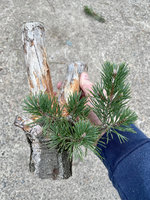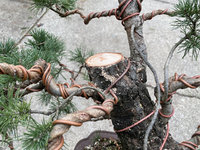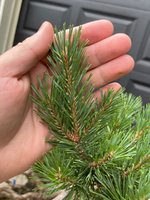parhamr
Omono
I thought I had a thread for this tree, but I guess I’ve only put it into the Tree Thread. Here we go!
I scored a Telperion Scots Pine in 2017 for a song. It was in their bargain section, having been almost fully infected by needlecast (causing massive loss of interior buds and branches). This was part of a Mirai excursion and Ryan assigned me this tree as a challenge. I don’t have pics from the first year, but it was in a sad state. This was one of their classic trees in a grow bag burrowed into the field, having been grown to about 15–20 feet tall about twice and then chopped by chainsaw. The woody trunk and fused roots had nearly deprived the tree of any feeder tissue.
I repotted it March 2018 with the assistance of a mentor, picking the widest base, most interesting line (leaning to the right and forward), and a good enough set of branches to compliment that as the front. This pot was chosen for horticultural reasons and not necessarily for aesthetics. This was a leap of faith that, by using fundamental principles of design we would eventually get somewhere close to a pleasing appearance …eventually.
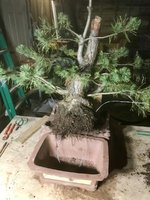
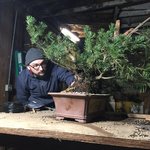
After this repotting a massive section of die back on the trunk decided to show itself — flaking off the bark that was hiding it. That probably explains a bit of its weaknesses and may have been from slightly sub-par positioning of the first major chainsaw cut. There is fortunately still enough of a live, bulging line of tissue around that section. It may be covered over in 5 more years.
By September 2018 it was pretty clearly focused on rebuilding good roots, but the meager foliage response was healthy enough to feel secure about its recovery.
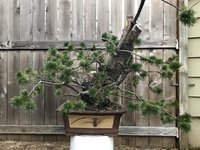
By September 2019 it was starting to show great color and strength on the new foliage and buds. It was also quite a good growing season, weather wise.
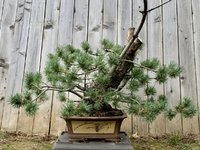
In February 2020 I showed it off to my peers for the first at BSOP mentorship. A couple elders had interesting ideas about rotating it about 135 degrees counterclockwise to de-emphasize the upright, leaning trunk. I agreed it would have been interesting but was still committed to this front. This was my first application of wire and the main goal here was to get some movement into the branches, compact a bit of the long branching, and to start just enough of its design language.
Wired:
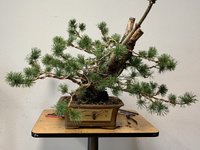
Styled:
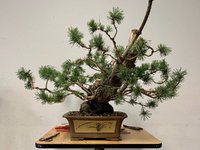
By October 2020 the tree was still fully a “go” on all horticultural signals. I had to remove some wire where it had started to bite in.
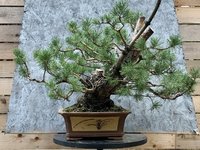
Having seen a successful regeneration of roots and positive foliage response, in late Februrary 2021 I decided to give the tree more space to support a period of bulking up:
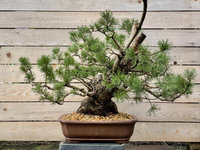
The mycorrhizae looked a treat
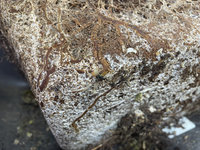
Continued…
I scored a Telperion Scots Pine in 2017 for a song. It was in their bargain section, having been almost fully infected by needlecast (causing massive loss of interior buds and branches). This was part of a Mirai excursion and Ryan assigned me this tree as a challenge. I don’t have pics from the first year, but it was in a sad state. This was one of their classic trees in a grow bag burrowed into the field, having been grown to about 15–20 feet tall about twice and then chopped by chainsaw. The woody trunk and fused roots had nearly deprived the tree of any feeder tissue.
I repotted it March 2018 with the assistance of a mentor, picking the widest base, most interesting line (leaning to the right and forward), and a good enough set of branches to compliment that as the front. This pot was chosen for horticultural reasons and not necessarily for aesthetics. This was a leap of faith that, by using fundamental principles of design we would eventually get somewhere close to a pleasing appearance …eventually.


After this repotting a massive section of die back on the trunk decided to show itself — flaking off the bark that was hiding it. That probably explains a bit of its weaknesses and may have been from slightly sub-par positioning of the first major chainsaw cut. There is fortunately still enough of a live, bulging line of tissue around that section. It may be covered over in 5 more years.
By September 2018 it was pretty clearly focused on rebuilding good roots, but the meager foliage response was healthy enough to feel secure about its recovery.

By September 2019 it was starting to show great color and strength on the new foliage and buds. It was also quite a good growing season, weather wise.

In February 2020 I showed it off to my peers for the first at BSOP mentorship. A couple elders had interesting ideas about rotating it about 135 degrees counterclockwise to de-emphasize the upright, leaning trunk. I agreed it would have been interesting but was still committed to this front. This was my first application of wire and the main goal here was to get some movement into the branches, compact a bit of the long branching, and to start just enough of its design language.
Wired:

Styled:

By October 2020 the tree was still fully a “go” on all horticultural signals. I had to remove some wire where it had started to bite in.

Having seen a successful regeneration of roots and positive foliage response, in late Februrary 2021 I decided to give the tree more space to support a period of bulking up:

The mycorrhizae looked a treat

Continued…


